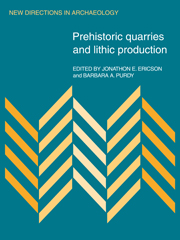Book contents
- Frontmatter
- Contents
- List of contributors
- Dedication
- Part 1 Introduction
- Part 2 Procurement, production, and exchange
- 2 Mount Jasper: a direct-access lithic source area in the White Mountains of New Hampshire
- 3 Procurement without quarry production: examples from southwestern Idaho
- 4 The 63-kilometer fit
- 5 Monopoly or direct access? Industrial organization at the Melos obsidian quarries
- 6 Lithic material demand and quarry production
- 7 Economic aspects of prehistoric quarry use: a case study in the American southwest
- 8 Preliminary report on the obsidian mines at Pico de Orizaba, Veracruz
- 9 State-controlled procurement and the obsidian workshops of Teotihuacán, Mexico
- Part 3 Technology and techniques
- Index
2 - Mount Jasper: a direct-access lithic source area in the White Mountains of New Hampshire
Published online by Cambridge University Press: 04 August 2010
- Frontmatter
- Contents
- List of contributors
- Dedication
- Part 1 Introduction
- Part 2 Procurement, production, and exchange
- 2 Mount Jasper: a direct-access lithic source area in the White Mountains of New Hampshire
- 3 Procurement without quarry production: examples from southwestern Idaho
- 4 The 63-kilometer fit
- 5 Monopoly or direct access? Industrial organization at the Melos obsidian quarries
- 6 Lithic material demand and quarry production
- 7 Economic aspects of prehistoric quarry use: a case study in the American southwest
- 8 Preliminary report on the obsidian mines at Pico de Orizaba, Veracruz
- 9 State-controlled procurement and the obsidian workshops of Teotihuacán, Mexico
- Part 3 Technology and techniques
- Index
Summary
Archaeological excavations at Mount Jasper, a rhyolite source in northern New England, reveal that it was exploited at a slow rate over 7,000 years. Although stone from the mountain was transported over a broad region, its movement was in the hands of miners rather than traders or other intermediaries. An unexpected benefit of the work at Mount Jasper was the discovery that workshops may yield three classes of artifacts. One of these classes, exhausted tools of exotic stones, holds valuable information about subsistence activities, the range of seasonal movements, and general culture history. Archaeologists can no longer afford to overlook this rich source of data in their studies of stone-tool-using groups.
The object of this discussion is to present the fruits of archaeological research at a small-scale lithic source area located in the White Mountains of New Hampshire, a region that was as thinly populated in prehistory as it is today. Mount Jasper is an example of a lithic resource that was consumed at a slow rate over a long period. The stone that was quarried there for flaked tools was not transported very far from the site. As we shall argue, the most economical explanation for the distribution of Mount Jasper stone is that users satisfied only personal needs. Since there is no evidence of exchange networks at any period in the region, there was no surplus production.
- Type
- Chapter
- Information
- Prehistoric Quarries and Lithic Production , pp. 11 - 22Publisher: Cambridge University PressPrint publication year: 1984
- 10
- Cited by

